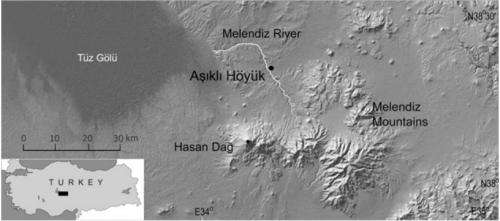April 29, 2014 report
Mound excavation reveals transition from hunting to herding in Neolithic settlement

(Phys.org) —A team of researchers with members from several countries has found evidence of the birth of pre-ceramic Neolithic populations in a region of what is now Turkey. In their paper published in Proceedings of the National Academy of Sciences, the team describes how excavations of various levels at Aşıklı Höyük, reveal the history of the people that lived there.
One of the great fascinating areas of archeological research is piecing together parts of the historical record that reveal major transitions, one of which is the move by early peoples from hunters to herders or farmers. In this new effort, the research team excavated a mound that developed due to human activities starting approximately 9000 years ago. The mound grew (to a height of approximately 52 feet) as people gathered and used mud and wood for building structures. As with many ancient cities, towns or settlements, levels developed, each representing a period of time. In this latest effort, the researchers focused on the deepest layers, representing the time when people first came to live there.
At the lowest level, the researchers found artifacts that indicated the people ate mostly meat from wild animals, such as deer, hares, fish, etc. Moving up one level, which represented a time span of just a few hundred years, the researchers found the diet had changed to one consisting mainly of meat from domesticated animals (goats and sheep) which of course marks the move from hunting to herding, or at least to raising animals for food. Other artifacts revealed that the animals were kept very near to the human dwellings, suggested they were stabled. The findings show that the transition from hunting to herding occurred over a remarkably short time frame, and offers evidence of the birth of pre-ceramic Neolithic populations in the area.
The researchers believe that the people who lived in or on the mound at the time that animals were being domesticated were also cultivating grain—for use in feeding both themselves and their animals. It was another major shift, they note, from a nomadic existence to one where groups of people settled in one place and grew their own food. Doing so would have required a wide array of adaptations that the team hopes to study as they continue to excavate the site.
More information: A forager–herder trade-off, from broad-spectrum hunting to sheep management at Aşıklı Höyük, Turkey, Mary C. Stiner, PNAS, DOI: 10.1073/pnas.1322723111
Abstract
Aşıklı Höyük is the earliest known preceramic Neolithic mound site in Central Anatolia. The oldest Levels, 4 and 5, spanning 8,200 to approximately 9,000 cal B.C., associate with round-house architecture and arguably represent the birth of the Pre-Pottery Neolithic in the region. Results from upper Level 4, reported here, indicate a broad meat diet that consisted of diverse wild ungulate and small animal species. The meat diet shifted gradually over just a few centuries to an exceptional emphasis on caprines (mainly sheep). Age-sex distributions of the caprines in upper Level 4 indicate selective manipulation by humans by or before 8,200 cal B.C. Primary dung accumulations between the structures demonstrate that ruminants were held captive inside the settlement at this time. Taken together, the zooarchaeological and geoarchaeological evidence demonstrate an emergent process of caprine management that was highly experimental in nature and oriented to quick returns. Stabling was one of the early mechanisms of caprine population isolation, a precondition to domestication.
Journal information: Proceedings of the National Academy of Sciences
© 2014 Phys.org



















